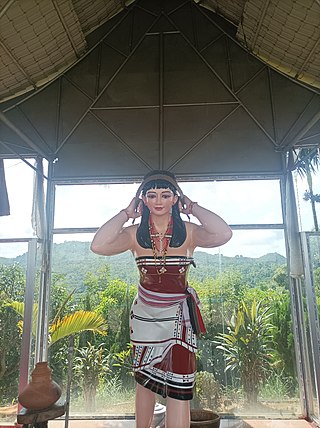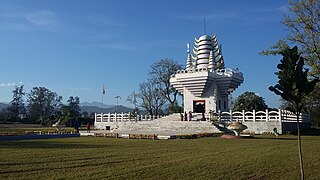
The Tangkhul people, also known as the Tangkhul , are a Tibeto-Burmese ethnic group living in the Indo–Mayanmar border area, occupying the Ukhrul district and Kamjong district in the Northeast Indian state of Manipur, and in parts of neighbouring Myanmar. Despite this international border, many Tangkhul have continued to regard themselves as "one nation". The name "Tangkhul" is originated from the Meitei language words, "Tang" meaning "scarce" and "Khul" meaning "village" respectively. According to another theory of origin, the term "Tangkhul" is derived from "Thankhul", meaning "Than village" in Meitei language.

Sanamahism, also known as Meiteism, or Lainingthouism is an ethnic religion of the Meitei people of Manipur, in Northeast India. It is a polytheistic religion and is named after Lainingthou Sanamahi, one of the most important deities of the Meitei faith. Sanamahi is the eldest son of the supreme god Sidaba Mapu and the supreme goddess Leimarel Sidabi. Traditionally every Meitei household, irrespective of the religion, worships Sanamahi and Leimarel Sidabi. Sanamahism does not have a religious head but has a body, the Maru Loishang, that oversees the main religious activities and governs all affairs of the religion, including the conduct of priest and priestess. The Maru Loishang also acts a court for religious disputes. There are three main departments under the Manu Loishang, namely, the Amaiba Loishang, the Pena Asheiba Loishang, and the Amaibi Loishang. These departments have existed since the reign of King Meidingu Hongnemyoi Khunjao Naothingkhong of Manipur in 662 AD. Sanamahi is the eldest son of the supreme god Sidaba Mapu and the supreme goddess Leimarel Sidabi.

Lai Haraoba is a traditional Meitei religious festival of ritual dance and musical theatre, celebrated annually in honour of Umang Lais, the forest deities of Sanamahism.

Manipuri Vaishnavism, also known as Meitei Vaishnavism is a regional variant of Gaudiya Vaishnavism with a culture-forming role in the north-eastern Indian state of Manipur.
Here is a list of glossary of culture of India in alphabetical order:

Imoinu or Emoinu is a goddess associated with household, hearth, family, fireplace, kitchen, wealth, peace and prosperity in Meitei mythology and religion of Ancient Kangleipak. She is frequently associated with Leimarel Sidabi. She is regarded as one of the incarnations or representations of goddess Leimarel Sidabi.

Panthoibi, also known as Nongpok Leima, is a goddess associated with civilization, courage, fertility, handicraft, love, victory, warfare and wisdom in the mythology and religion of Ancient Kangleipak. She is a consort of the God Nongpok Ningthou. She is considered to be one of the divine incarnations of Leimarel Sidabi and is also identified as a form of Goddess Nongthang Leima. She is worshipped mainly by the Meitei people in Manipur, Assam, Tripura, Bangladesh and Myanmar.
The Meitei calendar or the Manipuri calendar or the Kangleipak calendar or the Maliyapham Palcha Kumshing is a lunar calendar used by the Meitei people of Manipur for their religious, agricultural and other cultural activities. New moon is counted as the end of each month and has twelve months in total. The concept of era in Meitei calendar was first developed by Emperor Maliyafam Palcha, in the year 1397 BC in the realm of Kangleipak in present-day Manipur. It is believed that the 2nd, 3rd, 4th, 6th and 7th months of the Meitei calendar were named after Poireiten's agricultural activities. Similar to Gregorian calendar, the Meitei calendar also consists of twelve months and seven days but the starting date with the Gregorian calendar is different. The new year day known as, Sajibu Cheiraoba is celebrated on the 1st day of the month Sajibu.

Panthoibi Iratpa or Panthoibi Iraat Thouni or Panthoibi Eratpa is a religious festival of the Meitei people dedicated to Panthoibi, the ancient Meitei goddess of civilization, courage, fertility, handicraft, love, victory, warfare and wisdom of Sanamahism. It is celebrated on the first day of the Meitei lunar month of Mera, based on the traditional Meitei calendar. It usually, though not always, coincides with the day of the Hindu festival of Durga Puja, which is based on the Hindu calendar. So, both the festival are often celebrated together in Manipur, despite their religious differences. Goddess Panthoibi is syncretised with Hindu goddess Durga since 1714 AD during the reign of emperor Pamheiba when he made Hinduism as the official religion of the Kingdom of Manipur.

Nongpok Ningthou, also known as the Sovereign of the East or King of the East, is a deity in Sanamahism, the indigenous religion of Manipur. He is the ruling guardian deity of the eastern direction. Legend says Nongpok Ningthou and his consort Panthoibi were united in the Nongmaiching Ching mountains. Later, they were worshipped as the civilization giving deities in Meitei religion.

Haoreima or Haoleima is a goddess of tragic love and separation in Meitei mythology and Sanamahism, the indigenous religion of Manipur.> According to some legends, she was a woman from the hills, who was killed while arranging to meet her lover, and turned into a tortured spirit. She is regarded as an incarnation of Goddess Panthoibi. She is also identified with the goddess Nongthang Leima.

Phouoibi or Phouleima is the goddess and the female personification of the agriculture, crops, fertility, grains, harvest, paddy, rice and wealth in Meitei mythology and religion of Ancient Kangleipak . She is the lover of Akongjamba, a hero in ancient legends. But fate does not permit the lovers to unite. So, Phouoibi and Akongjamba reincarnated in the legends. She was sent by Thangching to Moirang) kingdom to make the human world prosperous. The legends of her love with Akongjamba were believed to be enacted by Thangching as a part of the Moirang Saiyon legends.

Noinu Thumleima or Thumkhong Lairembi is the Meitei goddess of salt.

Thangching or Thangjing is a primordial deity in Sanamahism, the indigenous religion of Manipur. He is the ruling deity of the Moirang dynasty. He rules supreme on the banks of the landlocked sea, Loktak lake. He is one of the four cardinal Umang Lais. The guardianship of the south western direction is alluded to Thangjing and the other directions to Koubru, Marjing and Wangbren.

The culture of Meitei civilization evolved over thousands of years, beginning in Ancient Kangleipak, continuing most notably into Medieval Kangleipak, while influencing the neighboring states and kingdoms, till present times.

The Panthoibi Khonggul, often misspelled as Panthoibi Khongul, is an ancient Meitei language text, narrating about the quest of deified Meitei princess Panthoibi. The text highlights the love story of Panthoibi and her ultimate lover Nongpok Ningthou, after leaving her former husband's house. It is traditionally attributed to be written by Akoijam Tombi, during the reign of Meitei King Khongtekcha Yoiremba in c. 763 AD.

Meitei festivals are an integral part of the cultural heritage of the Meitei people, an ethnic group native to the Indian state of Manipur. The festivals often celebrate events from Ancient Manipur and often coinciding with seasonal changes. These festivals reflect the unique customs and traditions of the Meitei community, and are celebrated with great enthusiasm and zeal. There are various festivals celebrated throughout the year, each with its own significance and rituals.

Jagoi refers to the arts of dance in Meitei culture.

Ancient Meitei literature, also termed as Old Manipuri literature, is literature written in the Old Manipuri language from the earliest texts until the time of King Pamheiba. All the ancient Meitei literary works are written in the traditional Meitei script. The ancient Meitei language texts, written in Meitei script, are conventionally termed as "the puyas".












